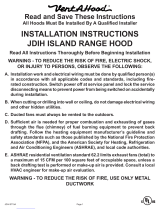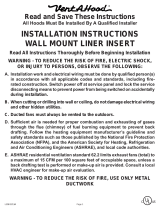Page is loading ...

Page 1L114A 0514A
U
L
CUS
R
Read and Save These Instructions
All Hoods Must Be Installed By A Qualied Installer
INSTALLATION INSTRUCTIONS
K-SERIES UNDER CABINET HOOD
Read All Instructions Thoroughly Before Beginning Installation
WARNING - TO REDUCE THE RISK OF FIRE, ELECTRIC SHOCK,
OR INJURY TO PERSONS, OBSERVE THE FOLLOWING:
A. Installation work and electrical wiring must be done by qualied person(s)
in accordance with all applicable codes and standards, including re-
rated construction. Switch power off at service panel and lock the service
disconnecting means to prevent power from being switched on accidentally
during installation.
B. When cutting or drilling into wall or ceiling, do not damage electrical wiring
and other hidden utilities.
C. Ducted fans must always be vented to the outdoors.
D. Sufcient air is needed for proper combustion and exhausting of gases
through the ue (chimney) of fuel burning equipment to prevent back
drafting. Follow the heating equipment manufacturer’s guideline and
safety standards such as those published by the National Fire Protection
Association (NFPA), and the American Society for Heating, Refrigeration
and Air Conditioning Engineers (ASHRAE), and local code authorities.
E. ASHRAE residential ventilation standard 62.2 limits exhaust fans (total) to
a maximum of 15 CFM per 100 square feet of occupiable space, unless a
back drafting test is performed or make-up air is provided. Consult a local
HVAC engineer for make-up air evaluation.
WARNING - TO REDUCE THE RISK OF FIRE, USE ONLY METAL
DUCTWORK

Page 2L114A 0514A
Ducting Do’s and Don’ts
YES
NO
Smooth Duct
Smooth Gradual Turn
Flexible Duct
Sharp Angled Turns
General Requirements
• Observe local codes regarding special duct requirements and placement of duct against combustibles.
• UsingVent-A-Hoodtransitions(backpage)willensureproperefciency.
• UsingVent-A-Hoodroofjacksorwalllouvers(backpage)willensureproperefciency.
• Where possible, seal joints with duct tape.
• The hood must be ducted to the outdoors without restrictions.
Blower Requirements
• The K250 blower unit requires 7” round duct or equivalent (32.5 square inches).
Blower Duct Dize Sq. Inch Area Vent-A-Hood Transition
K250 3 1/4" x 10" or equivalent 32.5 sq. in. VP521 (Optional)
Ducting Requirements
• NEVER reduce the duct size.
• Donotuseexibleorcorrugatedduct.Thistypeofductwillrestrictairowandreduceperformance.
• Onlyusesmooth,galvanized,metalduct.
• Make the duct run as short and as straight as possible with as few turns as possible.
• Avoid sharp-angled turns. Instead, use smooth, gradual turns such as adjustable elbows or 45 degree
angled turns.
• Forductrunsover20feet,increasetheductdiameterbyoneinchforeverytenfeetofduct.
• A 90 degree elbow is equal to 5 feet of duct.
Termination Requirements
• Airowmustnotberestrictedattheendoftheductrun.
• A wall louver or roof jack is required for each duct run.
• Everywalllouverorroofjackmustincludeagravitydampertopreventbackdrafts.
• Do not use screen wire or spring-loaded doors on wall louvers or roof jacks.
• Donotterminateventingintoanatticorchimney.

Page 3L114A 0514A
Installation Details
1) Read all instructions thoroughly before beginning installation.
2) When installing the K-Series under cabinet hood, it is recommended that the bottom edge of the hood be located no
more than 21” - 24” above the cooking surface for optimum performance.
3) Inspect the underside of the cabinet for a ush mounting surface. If the underside of the cabinet is recessed, install
wood strips to provide a ush surface for the hood mounting screws to engage.
4) Determine whether the hood will discharge horizontally or vertically. The hood is shipped to discharge vertically but is
easily converted to horizontal discharge by exchanging the discharge adapter on top of the hood (4 screws) with the
discharge cover on the back of the hood (2 screws). Use duct tape to seal the discharge adapter and discharge cover
to the hood.
5) IF THE HOOD IS TO BE “BACK VENTED”, PROCEED DIRECTLY TO STEP 6.
Install the duct from the outside of the home down to the location of the hood exhaust outlet allowing room for the
VP521 transition on the top of the hood (if applicable). If a VP521 transition is used, install the duct down to the location
of the transition outlet plus 1”. This will allow the transition to engage 1” inside of the duct. Consult the connection
diagram (below) for further details on exhaust outlet placement.
Use duct tape to seal all joints. A complete listing of available Vent-A-Hood ducting materials is provided on the back
page of this instruction sheet.
Transition height: 3 1/4” x 10” duct will connect directly to the exhaust outlet of the hood. Optional VP521 transition
to 7” round (sold separately) is 7 1/2” tall.

Page 4L114A 0514A
Installation Details Continued
6) Remove the hood from its packaging and place on the oor or countertop in front of the cabinet where it will hang.
Warning: Do not operate hood without proper ground connection.
Warning: Make sure power is off and locked at the service disconnecting
means on the service panel during installation.
7) Determine whether the electrical wire will enter from the top or the back of the hood. Remove the electrical enclosure
cover (1 screw) and the top or back electrical enclosure knockout from the hood. Install an appropriate 1/2” UL listed
electrical wire clamp through the electrical knockout. Install electrical wiring from the electrical panel to the hood
location.
8) Insert the electrical wire through the electrical wire clamp allowing 3” - 4” of wire inside the enclosure for hookup.
Tighten the electrical wire clamp.
9) From inside the hood, using UL listed wire nuts, attach the “neutral” wire to the white lead, the “hot” wire to the black
lead, and the ground wire to the green lead inside the junction box. Replace the electrical cover previously removed
in Step 7.
10) FOR BACK VENTING APPLICATIONS ONLY. IF YOU ARE NOT BACK VENTING, PROCEED DIRECTLY TO STEP 12.
Note: Wall studs may interfere with back venting installations.
Additional framing may be required. It is necessary to cut a
duct access hole in the wall as shown in the diagram to the
right.
11) Install the duct from the outside of the home to the duct access
hole in the wall. Where possible, use duct tape to seal joints.
12) While aligning the duct and guiding the wires, position the
hood under the cabinet. The duct should connect together
as the hood is located in place. Note: Unless using the VP521
transition, the duct work must t inside the exhaust collar. If
using the VP521, 7” round duct should be placed with the non-
crimped end on the outside of the collar of the VP521 exhaust
outlet. Using the four screws provided, attach the hood to the
bottom of the cabinet.
14) Refer to the Owner Maintenance Guide Operating Instructions for proper hood operation. Test all blower and light
functions to ensure they are operating properly.
Model Volts Amps Hz RPM
CFM
Equivalent CFM
•
CFM
CFM
CFM
Minimum Round
Duct Size
Sones
#
K250 (Top Vent) 115 3.2 60 1550 250 375 223 220 190 7" (38 in.
2
) 7.4
K250 (Back Vent) 115 3.2 60 1550 220 330 196 194 167 7" (38 in.
2
) 7.4
•
Because the Magic Lung
®
blower uses centrifugal ltration rather than conventional bafe or mesh lters, the Magic Lung
®
blower can handle cooking equipment with higher cubic feet per minute (CFM) requirements and can deliver equivalent CFM much more
efciently than other than other ltration systems. When comparing the Magic Lung
®
with other blower units made by other manufacturers, use the “Equivalent CFM”.
#
Ratings in accordance with the Standard Test Code by the Energy Systems Laboratory of the Texas Engineering Experiment Station.

Page 5L114A 0514A
VENTING ACCESSORIES
6” RECTANGULAR DUCT PIPE
MODEL DIM
VP507 6” x 8 ½”
24”
8 ½”
6”
ROUND DUCT PIPE
MODEL DIM
VP500
VP501
VP502
6” Round
7” Round
8” Round
36”
6”
7”
8”
3 ¼” RECTANGULAR DUCT PIPE
MODEL DIM
VP504
VP505
VP506
3 ¼” x 10”
3 ¼” x 12”
3 ¼” x 16”
30”
10”
12”
16”
3 ¼”
OFFSET L & R TRANSITION
FOR ISLAND BLOWERS
MODEL DIM
VP542
VP543
Top Left
Top Right
8”
12”
5”
16”
SIDE VENT TRANSITION L & R
FOR ISLAND BLOWERS
MODEL DIM
VP544
VP545
Left Side
Right Side
19”
8”
16”
5”
OFFSET KIT - RECTANGULAR
MODEL DIM
VP550 6” Rnd to 3 ¼” x 10”
16”
11”
6”
11”
3 ¼”
10”
STANDARD ISLAND TRANSITION
MODEL DIM
VP565 5” x 16” to 8”
8”
9”
16”
5”
CLUSTER BLOWER TRANSITION
MODEL DIM
VP564 8” & 8” to 12”
18 ½”
12”
11 ¼”
“Y” TRANSITION
MODEL DIM
VP517
VP518
VP551
8” & 8” to 12”
6” & 8” to 12”
6” & 8” to 10”
18”
10”
12”
3 ¼” x 10” BACK VENT ELBOW
MODEL DIM
VP559 3 ¼” x 10”
4 ¼”
10”
14”
3 ¼”
3 ¼”
MULTI-BLOWER TRANSITION
MODEL DIM
VP562
VP563
6” & 8” to 10”
8” & 8” to 12”
VP562 - 17 ½”
VP563 - 16 ½”
10”
12”
VP562 - 23 ¼”
VP563 - 30 ½”
3 ¼” x 10” TO 7” TRANSITION
MODEL DIM
VP521 3 ¼” x 10” to 7”
7”
7 ½”
3 ¼”
10”
LOW PROFILE ROOF JACK
(MAXIMUM 4/12 PITCH)
MODEL DIM
6 ½”
VP539
VP540
VP541
6” Round
7” Round
8” Round
16 ¾”
16 ¾”
LOW PROFILE ROOF JACK
(MAXIMUM 4/12 PITCH)
MODEL DIM
10 ½”
VP552
VP553
10” Round
12” Round
22 ½”
20 ¾”
ADJUSTABLE ELBOW
MODEL DIM
VP513
VP514
VP515
6” Round
7” Round
8” Round
6”
7”
8”
VP513 - 8 ½”
VP514 - 9 ⁄”
VP515 - 10 ⁄”
BACK/SIDE VENT ELBOW
MODEL DIM
VP561 8” to 6” x 8 ½”
12”
6”
16”
8” Round
8 ½”
WALL LOUVER
MODEL DIM
6”
7”
8”
8 ⁄”
VP526
VP527
VP528
6” Round
7” Round
8” Round
Back
View
1 ½” Flange
WALL LOUVER
MODEL DIM
11”
11”
VP554 10” Round
Back
View
1 ½” Flange
WALL LOUVER
MODEL DIM
13”
13”
VP555 12” Round
Back
View
1 ½” Flange
RECTANGULAR WALL LOUVER
MODEL DIM
3 ¼”
10”
VP538
VP560
6” x 8 ½“
3 ¼” x 10”
8 ½”
6”
1 ½” FLANGE
2” FLANGE
OFFSET KIT - ROUND
MODEL DIM
VP529 6” Rnd to 7” Rnd
16”
11”
6”
7”
10 ½”
LOW PROFILE ROOF JACK
(MINIMUM 4/12 PITCH)
MODEL DIM
10 ½”
VP552-HP
VP553-HP
10” Round
12” Round
22 ½”
20 ¾”
M1200 STANDARD TRANSITION
MODEL DIM
VP566 21” x 8” to 10”
10”
9”
8”
21”
LOW PROFILE ROOF JACK
(MINIMUM 4/12 PITCH)
MODEL DIM
6 ½”
VP539-HP
VP540-HP
VP541-HP
6” Round
7” Round
8” Round
16 ¾”
16 ¾”
/


